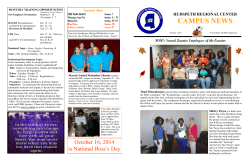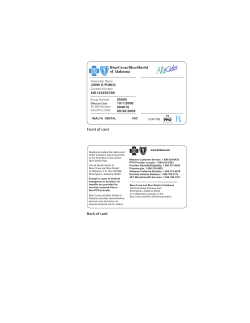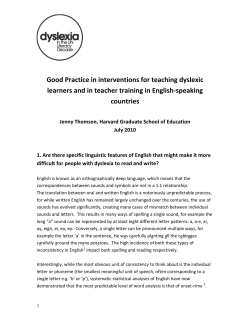
AL Dyslexia Bill Draft Meeting of the Minds
Alabama Dyslexia Bill of Rights: Recognize + Reach = Read 1! 2! Amendment to Alabama Admin Code Regulation 290-3-1-.20 (Problem Solving Teams) A Dyslexia Bill of Rights for Alabama 3! 4! AN ACT to ensure that Alabama’s students with dyslexia are provided with early identification 5! and dyslexia-specific intervention through general education in Alabama schools as part of the 6! problem solving team process and that individuals in Alabama be equipped to appropriately 7! serve Alabama’s students with dyslexia. 8! 9! SYNOPSIS: Under existing law, there is no specific requirement for children enrolled in 10! Alabama schools to be screened for dyslexia nor for students with dyslexia to be provided with 11! dyslexia-specific intervention. 12! This bill would create a legal definition of dyslexia applicable in the state of Alabama. 13! This bill would require each school district to provide dyslexia screening as defined in 14! this act for any student who scores below the 25th percentile in reading on the universal 15! screening currently being conducted with students in the district and/or for any student upon 16! teacher or parental or guardian request. 17! 18! 19! 20! This bill would make available dyslexia-specific teacher training and require dyslexicspecific professional development for Alabama teachers. This bill would require provision of appropriate educational services for students who fail the dyslexia screening provided by the district as outlined by this act. 21! Amendment 621 of the Constitution of Alabama of 1901, now appearing as Section 22! 111.05 of the Official Recompilation of the Constitution of Alabama of 1901, as amended, 23! prohibits a general law whose purpose or effect would be to require a new or increased 24! expenditure of local funds from becoming effective with regard to a local governmental entity 25! without enactment by a 2/3 vote unless; it comes within one of a number of specified 1!! Alabama Dyslexia Bill of Rights: Recognize + Reach = Read 1! exceptions; it is approved by the affected entity; or the Legislature appropriates funds, or 2! provides a local source of revenue, to the entity for the purpose. 3! The purpose or effect of this bill would be to require a new or increased expenditure of 4! local funds within the meaning of the amendment. However, the bill does not require approval 5! of a local governmental entity or enactment by a 2/3 vote to become effective because it 6! comes within one of the specified exceptions contained in the amendment. 7! A Bill 8! To Be Entitled 9! An Act 10! To create a legal definition of dyslexia applicable in the state of Alabama; to require 11! each school district to provide dyslexia screening as defined in this act for any student who 12! scores below the 25th percentile in reading on the universal screening currently being 13! conducted with students in the district and/or for any student upon teacher or parental or 14! guardian request; to make available dyslexia-specific teacher training and require dyslexic- 15! specific professional development for Alabama teachers; to require provision of appropriate 16! educational services for students who fail the dyslexia screening provided by the district as 17! outlined by this act; to require the Alabama Department of Education to promulgate rules for 18! the implementation of this act and to establish a dyslexia advisory council; and in connection 19! therewith would have as its purpose or effect the requirement of a new or increased 20! expenditure of local funds within the meaning of Amendment 621 of the Constitution of 21! Alabama of 1901, now appearing as Section 111.05 of the Official Recompilation of the 22! Constitution of Alabama of 1901, as amended. 23! 24! BE IT ENACTED BY THE LEGISLATURE OF ALABAMA: 25! Section 1. The Legislature finds and declares the following: 2!! Alabama Dyslexia Bill of Rights: Recognize + Reach = Read 1! (1) Dyslexia is a life-long learning difference found in at least 10% of the population. 2! (2) The graduation rate for individuals with dyslexia is considerably lower than the 3! graduation rate of the general education population despite the fact that individuals with 4! dyslexia have normal intelligence. 5! (3) More than half of all inmates in the United States are illiterate and many of those have 6! dyslexia. 7! (4) Further difficulties of students with dyslexia often are witnessed in impairments in 8! handwriting, written expression, rote math calculations, speech, word retrieval, and pro- 9! cessing speed.! 10! (5) Schools have a history of limiting needed interventions for students with dyslexia to 11! only those students who also have an established, long history of reading failure and who 12! therefore qualify under State and Federal Regulations for Special Education Services as 13! students with Specific Learning Disabilities. 14! (6) Without early identification and dyslexia-specific intervention, students with 15! dyslexia are likely to experience long-term, serious academic disabilities; reduced 16! self-esteem; increased emotional and social difficulties; and will be at significant risk 17! for dropping out of school. 18! (7) Early identification and appropriate dyslexia-specific early intervention provided 19! through general education will significantly reduce the negative academic and 20! social impacts of dyslexia thereby equipping individuals with dyslexia to be literate, 21! productive Alabama citizens, realizing their full potential and contributing to the 22! economic well-being of Alabama. 23! Section 2. As used in this act, the following words and phrases shall have the following 24! respective meanings: 3!! Alabama Dyslexia Bill of Rights: Recognize + Reach = Read 1! (1) DYSLEXIA. Dyslexia is a specific learning disability that is neurological in origin. 2! It is characterized by difficulties with accurate and/or fluent word recognition and by 3! poor spelling and decoding abilities. These difficulties typically result from a deficit 4! in the phonological component of language that is often unexpected in relation to 5! other cognitive abilities and the provision of effective classroom instruction. 6! Secondary consequences may include problems in reading comprehension and 7! reduced reading experience that can impede growth of vocabulary and background 8! knowledge. 9! (2) DYSLEXIA-SPECIFIC INTERVENTION. Dyslexia-specific intervention shall mean 10! evidenced-based, specialized reading, writing, and spelling instruction that is multisensory 11! in nature equipping students to simultaneously use multiple senses (vision, hearing, touch, 12! and movement). Dyslexia-specific intervention employs direct instruction of systematic 13! and cumulative content. The sequence must begin with the easiest and most basic 14! elements and progress methodically to more difficult material. Each step must also be 15! based on those already learned. Concepts must be systematically reviewed to strengthen 16! memory. Components of dyslexic-specific intervention include instruction targeting 17! phonological awareness, sound symbol association, syllable structure, morphology, syntax 18! and semantics. 19! (3) DYSLEXIA-SPECIFIC SCREENING. (a) Dyslexia-specific screening for students in 20! grades 1-12 must provide the student with an opportunity to demonstrate phonemic 21! decoding efficiency skills, sight word reading efficiency skills, spelling skills, and accuracy 22! of word reading in on-grade-level text. Students who achieve standard scores below the 23! 25th percentile on norm-referenced phonemic decoding efficiency, sight word reading 24! efficiency assessments, and spelling and who read on-grade-level text with less than 90% 4!! Alabama Dyslexia Bill of Rights: Recognize + Reach = Read 1! accuracy as they complete the screening will be determined to have failed the dyslexia- 2! specific screening. 3! (b) Dyslexia-specific screening for students in kindergarten must provide the student with 4! an opportunity to demonstrate letter naming skill, letter sound skill, and phoneme 5! segmentation skill. Students who achieve scores revealing well-below benchmark 6! performance and a need for intensive intervention support in all three skill areas will be 7! provided with dyslexia-specific intervention. 8! (4) UNIVERSAL SCREENING. Universal screening refers to procedures used to 9! determine performance levels of students in academic content areas including reading. 10! Universal screening is conducted at specified intervals as a part of the school’s problem 11! solving team (PST) process in their efforts to guide general education intervention services 12! for all students. 13! (5) DYSLEXIA-SPECIFIC TEACHER TRAINING. Dyslexia-specific teacher training refers 14! to completion of a certification training course in implementation of multisensory structured 15! language teaching techniques and strategies. This certification training course must be 16! provided by a Qualified Instructor (QI) and must be provided by an International 17! Multisensory Structured Language Education Council (IMSLEC) accredited course or 18! through a certification training course accredited by the International Dyslexia Association 19! (IDA). 20! (6) INDIVIDUALS. The term individuals refers to those who have at least a bachelor’s 21! degree from an accredited college or university and who serve as dyslexia-specific 22! interventionists. 23! (7) DYSLEXIA INTERVENTIONIST. Dyslexia interventionist refers to the teacher or 24! individual who provides dyslexia-specific intervention. The dyslexia interventionist shall 5!! Alabama Dyslexia Bill of Rights: Recognize + Reach = Read 1! have successfully completed a certification training course as defined in this Act or shall 2! have completed training in the appropriate implementation of the evidence-based, 3! dyslexia-specific intervention being provided. 4! (8) DYSLEXIA-SPECIFIC PROFESSIONAL DEVELOPMENT. Dyslexia-specific 5! professional development refers to professional development targeting dyslexia 6! awareness, dyslexia-specific screening, dyslexia-specific classroom strategies, academic 7! accommodations, and use of assistive technology. 8! (9) PROGRESS MONITORING. Progress monitoring refers to repeated assessment of 9! skills being targeted within dyslexia-specific intervention. Progress monitoring is utilized to 10! determine the student’s response to dyslexia-specific intervention and may be used to 11! calculate the student’s rate of improvement (ROI). 12! (10) DYSLEXIA ADVISORY COUNCIL. Dyslexia advisory council refers to a group 13! including representatives from dyslexia advocacy groups, dyslexia interventionists, 14! teachers, and educational specialists from the Alabama Department of Education. 15! Section 3. (a) (1) Each school district will provide dyslexia screening as defined in this Act for 16! any student who scores below the 25th percentile in overall reading or in any reading skill area 17! included on the universal screening currently being conducted with students in the district 18! and/or for any student upon teacher or parental or guardian request. 19! (2) The screening of all students shall be performed with fidelity following the guidelines 20! promulgated by the Alabama Department Education as implemented by the school district. 21! (3) Dyslexia-specific screening for students in grades K-12 will be conducted for all 22! students scoring below the 25th percentile in overall reading or in any reading skill area 23! included on the Universal screener used by the district or whose teacher or parent/guardian 24! requests dyslexia-specific screening. 6!! Alabama Dyslexia Bill of Rights: Recognize + Reach = Read 1! (4) Dyslexia-specific screening for grades 1-12 must provide the student with an 2! opportunity to demonstrate: 3! (a) phonemic decoding efficiency skills; 4! (b) sight word reading efficiency skills; 5! (c) spelling skills; 6! (d) accuracy of word reading in on-grade-level text. 7! (5) If a student achieves scores in the below average range (below the 25th percentile or 8! less than 90% word reading accuracy) on three of the four components of the dyslexia- 9! specific screening, the student will be provided with dyslexia-specific intervention. 10! (6) Dyslexia-specific screening for students in kindergarten must provide the student with an 11! opportunity to demonstrate: 12! (a) letter naming skills 13! (b) letter sound skills 14! (c) phoneme segmentation skills (ability to break words into parts) 15! (7) Students who achieve scores revealing well-below benchmark (scores below the cut 16! point for risk) performance and a need for intensive support in all three skill areas will be 17! provided with dyslexia-specific intervention. 18! Section 4. (a) Individuals in Alabama will be provided with opportunities to participate in a 19! dyslexia-specific certification training course. 7!! Alabama Dyslexia Bill of Rights: Recognize + Reach = Read 1! (1) The dyslexia-specific certification training course will prepare individuals to implement 2! multisensory structured language teaching techniques and strategies. 3! (2) This certification training course must be provided by a Qualified Instructor (QI). 4! (3) This certification training course must be accredited through the International 5! Multisensory Structured Language Education Council (IMSLEC) or through the 6! International Dyslexia Association (IDA). 7! (b) Each school district shall ensure that all teachers receive four hours of professional 8! development annually targeting: 9! (1) dyslexia awareness; 10! (2) dyslexia-specific screening; 11! (3) dyslexia-specific classroom strategies; 12! (4) academic accommodations; and 13! (5) use of assistive technology. 14! Section 5. Students who fail the dyslexia screening will be provided with appropriate education 15! services within general education. Appropriate education services will include dyslexia-specific 16! intervention, academic accommodations as appropriate, and access to assistive technology as 17! appropriate. 18! (a) Students will participate in dyslexia-specific intervention as defined in this Act. 19! (1) The dyslexia-specific intervention will be provided for one hour daily and group size 20! will not exceed five. 21! (2) The dyslexia-specific intervention will be delivered with consistent fidelity and 22! adherence to author or publisher guidelines and recommended best practices. 23! (3) Students will participate in ongoing progress monitoring as defined in this Act. 24! (4) The Problem Solving Team (PST) will provide parents of students receiving 25! dyslexia-specific intervention with detailed information regarding intervention goals, 8!! Alabama Dyslexia Bill of Rights: Recognize + Reach = Read 1! specific skills targeted, and at periodic intervals with detailed, data-based progress 2! monitoring reports reflecting the student’s response to the dyslexia-specific intervention. 3! (5) The Problem Solving Team (PST) will convene to meet with parents as requested to 4! discuss the student’s participation in the dyslexia-specific intervention should the 5! parents make such a request. 6! (6) Dyslexia-specific intervention will be provided by a dyslexia interventionist as 7! defined in this Act. 8! (b) If it is determined that a student who has failed the dyslexia-specific screening has 9! functional difficulties in the academic environment, the necessary accommodations for the 10! student shall be provided as authorized under Section 504 of the Rehabilitation Act of 1973, 29 11! U.S.C. § 794 and Title II of the Americans with Disabilities Act, 42 U.S.C. § § 12! (c) If it is determined that a student who has failed the dyslexia-specific screening has 13! functional difficulties in the academic environment, the necessary assistive technology and 14! equipment for the student shall be provided as authorized under Section 504 of the 15! Rehabilitation Act of 1973, 29 U.S.C. § 794 and Title II of the Americans with Disabilities Act, 16! 42 U.S.C. § § 17! Section 6. The student’s response to dyslexia-specific intervention should be monitored by the 18! Problem Solving Team (PST) as outlined in the Alabama State Board of Education State 19! Department of Education Alabama Administrative Code Chapter 290-3-1 Public School 20! Governance SUPP. 6/30/14 Chapter 290-3-1-.02 (20) (a-d). The dyslexia interventionist 21! providing the dyslexia-specific intervention shall be a participant in the PST as the student’s 22! data and response to dyslexia-specific intervention are being reviewed. 23! (a) If a student’s progress monitoring data and the dyslexia interventionist’s 24! observations reveal less than adequate or expected growth in literacy skills, the PST 25! may consider a referral for a comprehensive evaluation as outlined in the Alabama 9!! Alabama Dyslexia Bill of Rights: Recognize + Reach = Read 1! Administrative Code, Rules of the Alabama State Board of Education, Department of 2! Education, Chapter 290-8-9, Special Education Services; 290--8-9-.01(1)(a-c) Child 3! Identification, page 497. 4! Section 7. 5! (a) The Alabama Department of Education shall adopt rules to implement this act. 6! (b) The Alabama Department of Education working with the Dyslexia Advisory Council 7! shall develop and maintain an approved dyslexia resource guide for school districts, 8! public schools, teachers, and parents and/or guardians. 9! Section 8. Although this bill would have as of its purpose or effect the requirement of a new 10! or increased expenditure of local funds, the bill is excluded from further requirements and 11! application under Amendment 621, now appearing as Section 111.05 of the Official 12! Recompilation of the Constitution of Alabama of 1901, as amended, because the bill requires 13! expenditures only by a school board. 14! Section 9. This act shall become effective on the first day of the third month following its 15! passage and approval by the Governor. 16! 17! 18! 19! 20! ! 10!
© Copyright 2025









